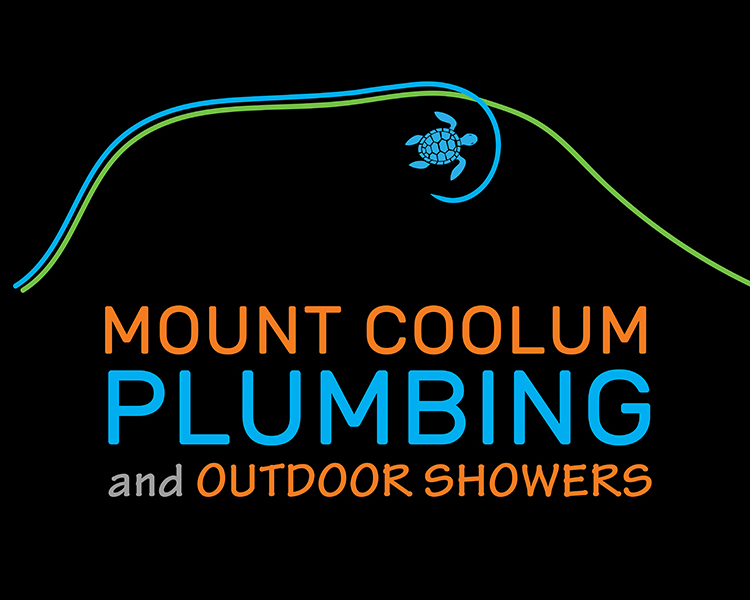HOT WATER SYSTEMS
Due to the many different types, brands and sizes, it can be a difficult process choosing the correct unit for you and your family. While it is usually easiest to just replace a hot water unit 'like for like', sometimes there are better options that should be considered.
To help you make the right choice, you need a plumber who can outline the different options, including the type, brand, model and size that suits your needs. To help you make an informed decision, the following information is an outline of some of the aspects you and your plumber need to consider.
So if you live in any of the following suburbs, please feel free to call/text me anytime on 0493 027 027 or use the email, Whatsapp or Facebook icons you will see on your sceen. I'm looking forward to hearing from you!
Twin Waters | Pacific Paradise | Mudjimba | Marcoola | Mount Coolum | Yaroomba | Point Arkwright | Coolum Beach | Peregian Beach | Marcus Beach | Peregian Springs
***TIP: You can click on each suburb to visit the profile page! Here you will find info about the suburbs as well a list of the types of job I have done in each area. Some of these pages may still be under construction ***
Restricted Electrical Licence
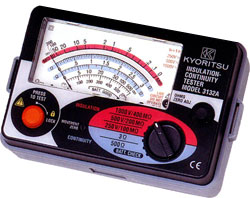
Does your plumber have one?
It is a legal requirement that the plumber holds a Restricted Electrical License if they will be disconnecting or reconnecting the electrical wires to a hot water unit. This includes the work needed to replace the thermostat and element.
When you're choosing a plumber to do the job, please ask them whether they hold a Restricted Electrical Licence and if they will be carrying out the required electrical safety tests.
I hold a licence and ALWAYS carry out the required testing. This ensures you and your family are safe from a possible dangerous situation and also ensures my insurance will cover any liabilities on my behalf.
Tempering Valves

To prevent the possibility of scalding, it is now law in Queensland that any hot water being delivered to bathroom fixtures, (showers, baths and basins) be no greater than 50 degrees Celsius.
Tempering Valves are therefore required to be fitted to any new or replacement hot water unit.
A Tempering Valve works by mixing the heated water (at least 60 degrees) coming out of the hot water unit with cold water to regulate a temperature of no greater than 50 degrees.
Hot water to the kitchen sink and laundry tub is still permitted to be delivered at 60 degrees, so, when possible, it is preferable to leave the hot water line to these fixtures untempered. Although, this is often not feasible at certain houses, due to the existing pipework being hard to access. In these cases it is far cheaper to temper the hot water to the entire house.
Also, due to the widespread usage of Dishwashers, having very hot water in the kitchen for handwashing dishes isn't always neccessary.
Power Tariffs
There are 3 different power tariffs available to residential customers - Tariff 11, Tariff 31 and tariff 33.
(NOTE: These are the labels that Origin Energy use, other suppliers may use different names/numbers, but the Tarrifs are identical)
Which tariff you should be on will depend on a few different factors, including:
- Type of unit
- Size of the unit
- Number of people in the home
Tariff 11
Tariff 11 is a continuous tariff which will supply power 24 hours a day. This is the most expensive tariff and is unnecessary for domestic hot water units.
Tariff 33
Tariff 33 supplies power for at least 18 hours per day, usually outside the peak period of 4pm-8pm and costs approximately 32% less than tariff 11.
This tariff should always be used for storage units of 125 Litre capacity and below. This is because at these smaller sizes, the hot water can be diminished very quickly and if power is not available to the unit, you may have to wait until the following day before the water will be reheated to the desired temperature. This tariff may also be required for larger units depending on the number of people in the household and their hot water consumption.
Most Heat Pumps of any size are also recommended to be on tariff 33, but certain high quality units such as the Siddons Heat Pump may function well on the cheaper tariff 31.
Tariff 31
Tariff 31 is the cheapest power tariff and costs approximately 52% less than Tariff 11.
This tariff is recommended for storage hot water units of 250 litres capacity and above as long as the unit is sized correctly to the number of people in the household.
Tariff 31 only supplies power for a minimum of 8 hours per day, usually between the times of 10pm-6am.
Types of Hot Water Unit

Electric
There are three main types of electric hot water unit, Mains Pressure Storage, Heat Exchange and Heat Pump
Storage
Mains Pressure Storage units consist of a holding tank, heating element/s and a thermostat. Water is stored in the tank, which is heated by the element to the temperature defined by the thermostat. (Must be at least 60 degrees Celsius to prevent the possible growth of the legionella bacteria)
As heated water is drawn from the top of the tank, it is replaced by cold water, which causes the temperature in the tank to drop. When the temperature in the tank drops below that set by the thermostat, the heating element will turn on and the heating process will begin.
The time it takes to recover the water in the tank to the desired temperature will depend on the size of the tank, the power of the heating element/s and the power tariff that your hot water circuit is on.
Heat Exchange
Heat Exchange units, or 'Saxons' as they are generically called, work by heating the water in the tank to a very high temperature. When a hot water tap is opened, cold water flows through a copper coil inside the tank and is heated as it passes through the very hot water stored in the tank.
The mass manufacture of Heat Exchange units ceased in 2011, so they are no longer an option for a replacement, but there are still many of these units operating reliably throughout the Sunshine Coast. Parts are also still available for servicing.
Solar
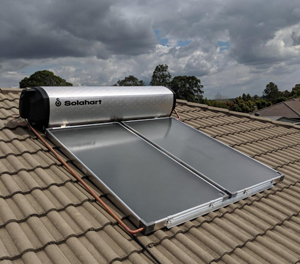
There are 2 types of Solar Hot Water units, Roof Mounted (complete) and Spilt System (Tank on ground)
Roof Mounted
Roof Mounted systems consist of both the tank and collectors mounted together as one unit on the roof.
(While Mount Coolum Plumbing does not install or replace Roof Mounted systems, we do service and repair them if possible.)
Split System

Split System Solar systems consist of roof mounted collectors as usual, but the tank is able to remain on the ground.
This type of system has become very popular over recent years mainly due to the advantage of not having to mount the very heavy tanks on the roof.
The disadvantage to this system is the added complexity. To cycle the sun heated water from the roof collectors into the ground mounted tank, sensors, a control box and a pump are needed.
It can sometimes be quite difficult to work out which of these parts is the main cause of the failure, so a plumber with experience in this fault diagnosis is required.
Mount Coolum Plumbing can service and replace all types of Split System solar hot water units.
Heat Pump
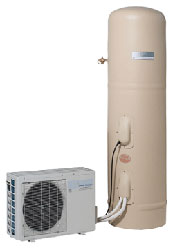
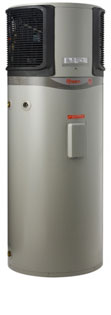
Heat Pumps are a Mains Pressure Storage type of hot water unit. These systems 'may be' more economical to run than a standard electric storage unit, with good quality Heat Pumps using as little as 33% of the power of a standard electric unit.
(NOTE: The reason I say 'may be' more economical is that while Heat Pumps do use less power to heat the water than a standard Electric Storage unit, they are also a far more complex system. This means that if repairs are needed to the heat pump system, any money you may have saved over the previous years can quickly be used up repairing the system.)
They work by taking the hot air surrounding the unit and transferring that heat into the water in the tank. Electricity is still required to raise the temperature, but the amount required is far less than a conventional storage unit.
Heat Pumps come in two styles: a single unit, where the heat pump is connected either on top or on the side of the tank, or a split system, where the tank and heat pump are two separate units.
They can be installed either indoors or outdoors, but a split system unit is required for indoor use. In this case, the storage tank is installed indoors, and the Heat Pump is installed outside nearby. Split systems can also be installed completely outdoors.
Gas
The two types of gas hot water units are; Mains Pressure Storage and Continuous Flow (also called Instantaneous.)
Storage

Gas Storage works exactly the same way as the electric version, except that instead of an electric heating element, it contains a gas burner, which activates when the temperature drops below that set be the thermostat.
Also, unlike their electric counterpart, gas storage units don't operate on a tariff and can supply heat 24 hours a day, when required. They will also recover to the required temperature far faster than an electric unit.
Continuous Flow

Continuous Flow (also called Instantaneous) units don't utilise a holding tank to store the hot water, instead, the water is heated 'instantaneously'.
When a hot water tap is opened , cold water flows through the unit activating the gas burner. As the water continues through the unit it passes through a heat exchanger which has been rapidly heated by the gas burner and the hot water is then delivered to the tap.
The main advantage of Continuous Flow units is that gas is only ever consumed when hot water is required, making them very economical to run.
While Continuous Flow units have been around for decades, the technology has made huge advancements in recent years with the introduction of electronically controlled units.
Previously, these units were ignited by either a continuously burning pilot light, a battery pack igniter or a water flow activated igniter. They also required the installer to adjust the unit's gas and water flow to allow it to operate satisfactorily during both summer and winter when different water temperatures and hot water flow rates were required.
While these units all had their time and place and are still being manufactured, they are far less efficient, reliable and 'smart' than electronically controlled units.
Electronically controlled units will sense the slightest change in water flow and constantly make adjustments to always supply consistent water temperatures to multiple outlets running at the same time and can also supply a far larger volume of hot water than the older style units.
One small downside to installing a new continuous flow unit is, because they are controlled electronically, a power outlet will need to be installed within 1.5 meters of the unit.
Sizing Hot Water Units
Which size of hot water unit you require depends on a number of factors including;
- Type of unit
- Number of people in household
- Power tariff
The tables below are a guide to help you understand how hot water units are chosen for a particular situation.
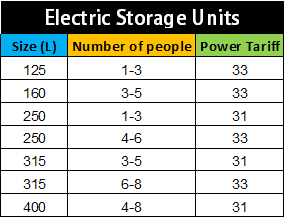
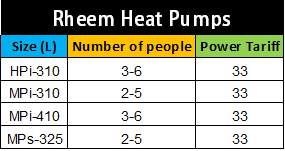
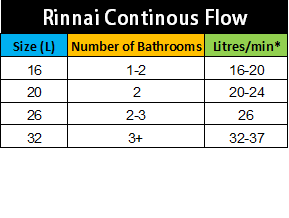
* Continuous Flow hot water units, are labeled with a number that represents the maximum amount of water delivered at a temperature rise of 25 degrees Celsius above ambient water temperature.
For example, if the ambient temperature of the cold tap water at your home is 15 degrees Celsius, the Rinnai Infinity 26 will be able to deliver a maximum of 26 litres per minute of water at a temperature of 40 degrees Celsius.
Of course, this doesn't mean that the unit can only supply heated water at 25 degrees above ambient temperature. The water will be supplied at higher temperatures if less water is being used.
For example, if you have a unit that can supply water at 60 degrees (with bathroom fixtures tempered separately to 50 degrees) and you are only using a kitchen tap, the unit will easily supply water to that tap at close to 60 degrees. This temperature will decline if more taps start being used (more water flow) and may eventually get to the maximum supply rate of 26 L/min at 25 degrees above ambient temperature.
The variance in litres per minute for some units in the table above, e.g. 16-20 for the Rinnai Infinity 16, is dependent on the climate of the area in which it is installed. Sunshine Coast residents should be able to expect something at the higher end of the range.
